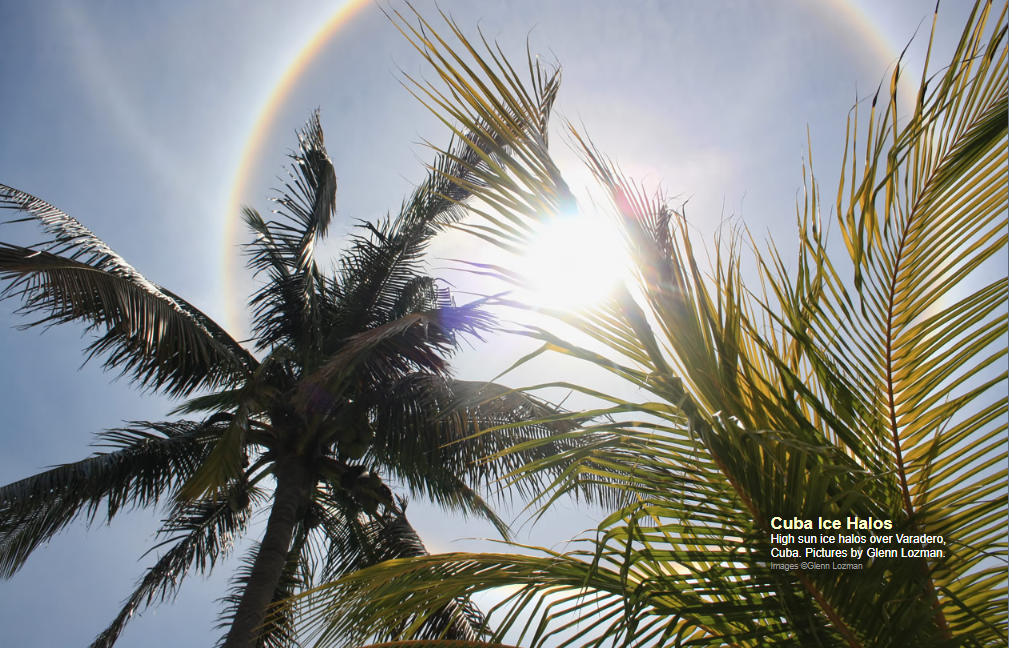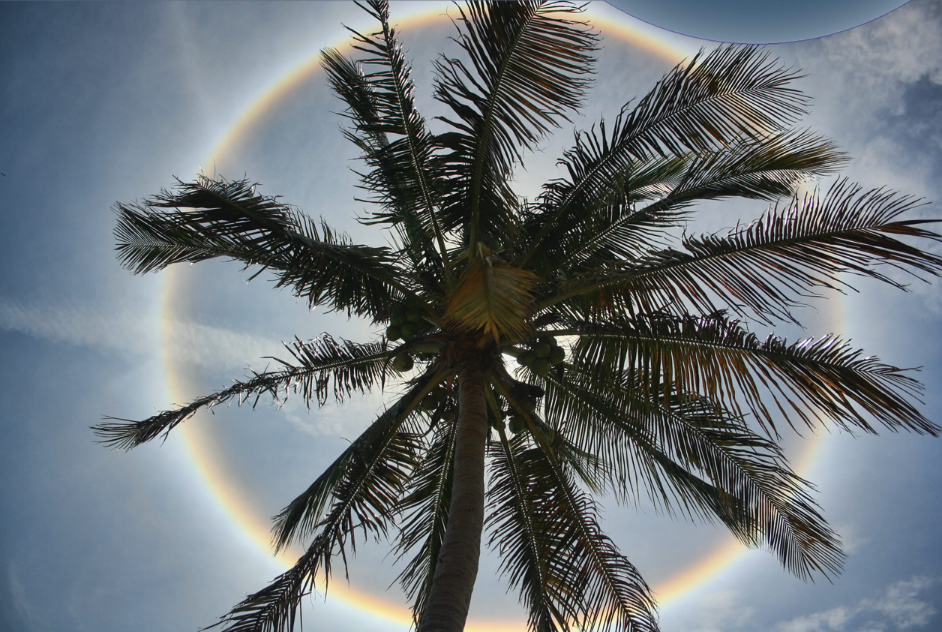OPOD - Cuba High Sun Halos
OPOD - Cuba High Sun Halos: A Fascinating Atmospheric Phenomenon
Have you ever marveled at the beauty of ice halos? You might think that these magnificent displays are exclusive to cold or Arctic regions, but that's not the case. High sun ice halos can appear anywhere, as long as there is a high and cold cirrus haze with optical quality ice crystals. One such stunning example was captured by Glenn Lozman in Varadero, Cuba.
The Circumscribed Halo: A Spectacular Sight
The top image reveals a sharp and brightly colored halo encircling the sun. While it may resemble a 22° halo at first glance, it is more likely a circumscribed halo. Formed from horizontal column crystals, the oval shape of the circumscribed halo tends to become more circular when the sun is high in the sky, as seen in the pictures taken at 65-75° elevation. Within this halo, a small and white parhelic circle gracefully curves through the sun.
Exploring the Intensely Colored Arcs
Beneath the circumscribed halo lies another intensely colored arc, which could either be an infralateral arc or a circumhorizon arc. Differentiating between the two can be challenging, but there are ways to discern them. The simulation and text provided in the left image help shed some light on this phenomenon. Additionally, Michael Ellestad spotted a faint lower Wegener arc tangent to the bottom of the circumscribed halo, adding to the captivating scene.
Unveiling the Oval Shape
In the lowest image, the oval shape of the circumscribed halo becomes evident. While there may be a hint of a circular 22° halo within it, touching at the top and bottom, the primary focus remains on the striking oval shape. This showcases the incredible diversity of ice halos and highlights their potential to captivate observers, even in unexpected locations like Cuba.
A Glimpse into the Crystal Structures
To gain further insight into these remarkable atmospheric phenomena, a HaloSim all-sky ray tracing was conducted for a 65° Cuban sun. The simulation employed a combination of horizontal column crystals, plate crystals, and randomly oriented crystals. The results revealed various halos, with the 22° halo from random orientations emphasizing the oval shape of the circumscribed halo generated by horizontal columns. Notably, the circumscribed halo appeared sharper and exhibited more saturated colors compared to other halos.
Deciphering the Origins of Arcs
One challenge in identifying specific arcs is distinguishing between a circumhorizon arc and an infralateral arc based solely on photographs. When observing these arcs, it is helpful to visually assess their alignment with the horizon. If an arc appears parallel to the horizon, it is more likely a plate crystal-generated circumhorizon arc. However, due to limited evidence near the sun of plate crystals when it is high, this distinction can be difficult to make accurately.
Conclusion: Nature's Artistry Knows No Bounds
The high sun ice halos witnessed in Cuba serve as a reminder that nature's artistry knows no bounds. Despite being associated with colder climates, these ethereal displays can manifest anywhere under the right atmospheric conditions. Whether it be the striking circumscribed halo, the captivating arcs, or the interplay between crystal structures, each element adds to the beauty and intrigue of these atmospheric optics phenomena. So keep your eyes on the sky, for you never know when nature will grace us with its awe-inspiring spectacles.

Cuba Ice Halos
High sun ice halos over Varadero, Cuba. Pictures by Glenn Lozman. Images ©Glenn Lozman

Top image: The sharp and brightly coloured halo circling the sun is more likely a circumscribed halo rather than a 22� halo. The circumscribed halo is formed from horizontal column crystals and at high sun (here 65-75� high) its oval shape tends more and more to circular. A small and white parhelic circle curves through the sun.
Left: Below the circumscribed halo is another intensely coloured arc � an infralateral arc or a circumhorizon arc. It is hard to tell which, see the simulation and text.
Michael Ellestad also spotted a faint lower Wegener arc tangent to the bottom of the circumscribed halo.
Lowest: Here the oval shape of the circumscribed halo is evident. Perhaps there is just a hint of a circular 22� halo within it and touching at top and bottom.
The images deny the belief that magnificent halos are the stuff only of cold or Arctic climes. They can appear anywhere if high and cold cirrus haze obliges with optical quality ice crystals.

At right a HaloSim all-sky ray tracing shows some possible halos for a 65° Cuban sun. The simulation used a mixture of horizontal column crystals, plate crystals and randomly oriented crystals.
The 22° halo from random orientations highlights the oval shape of the much brighter circumscribed halo produced by horizontal columns. The circumscribed halo is sharper with rather more saturated colours.
The parhelic circle results from reflections from the near vertical facets of columns (end faces) and plate crystals (side faces).
There is otherwise little evidence near the sun of plate crystals when the sun is high. This makes distinguishing between a circumhorizon arc and an infralateral arc purely from photographs difficult. When you see one, try to judge visually whether it is parallel to the horizon. If it is, then it is more likely a plate crystal generated circumhorizon arc.

Note: this article has been automatically converted from the old site and may not appear as intended. You can find the original article here.
Reference Atmospheric Optics
If you use any of the definitions, information, or data presented on Atmospheric Optics, please copy the link or reference below to properly credit us as the reference source. Thank you!
-
<a href="https://atoptics.co.uk/blog/opod-cuba-high-sun-halos/">OPOD - Cuba High Sun Halos</a>
-
"OPOD - Cuba High Sun Halos". Atmospheric Optics. Accessed on December 22, 2024. https://atoptics.co.uk/blog/opod-cuba-high-sun-halos/.
-
"OPOD - Cuba High Sun Halos". Atmospheric Optics, https://atoptics.co.uk/blog/opod-cuba-high-sun-halos/. Accessed 22 December, 2024
-
OPOD - Cuba High Sun Halos. Atmospheric Optics. Retrieved from https://atoptics.co.uk/blog/opod-cuba-high-sun-halos/.